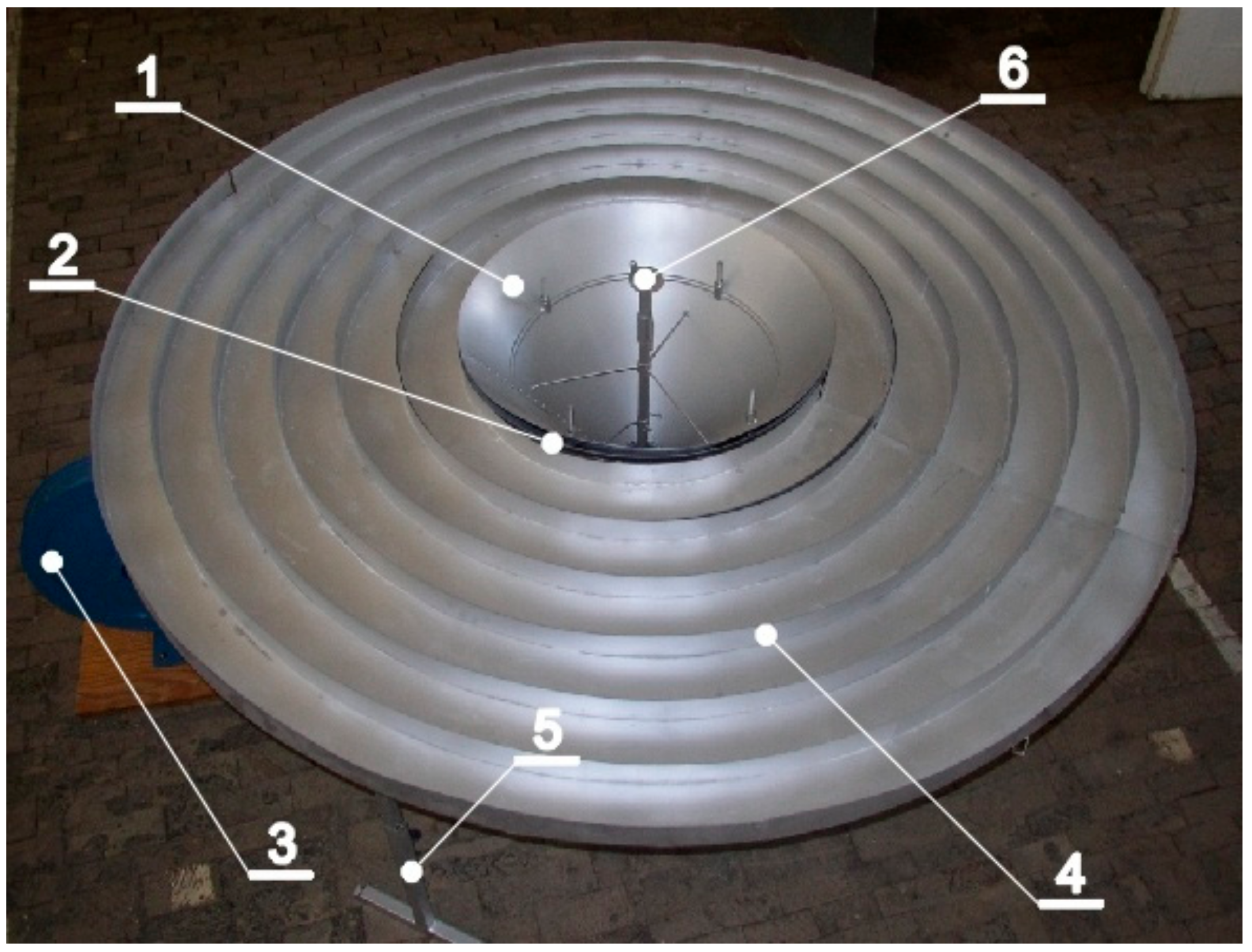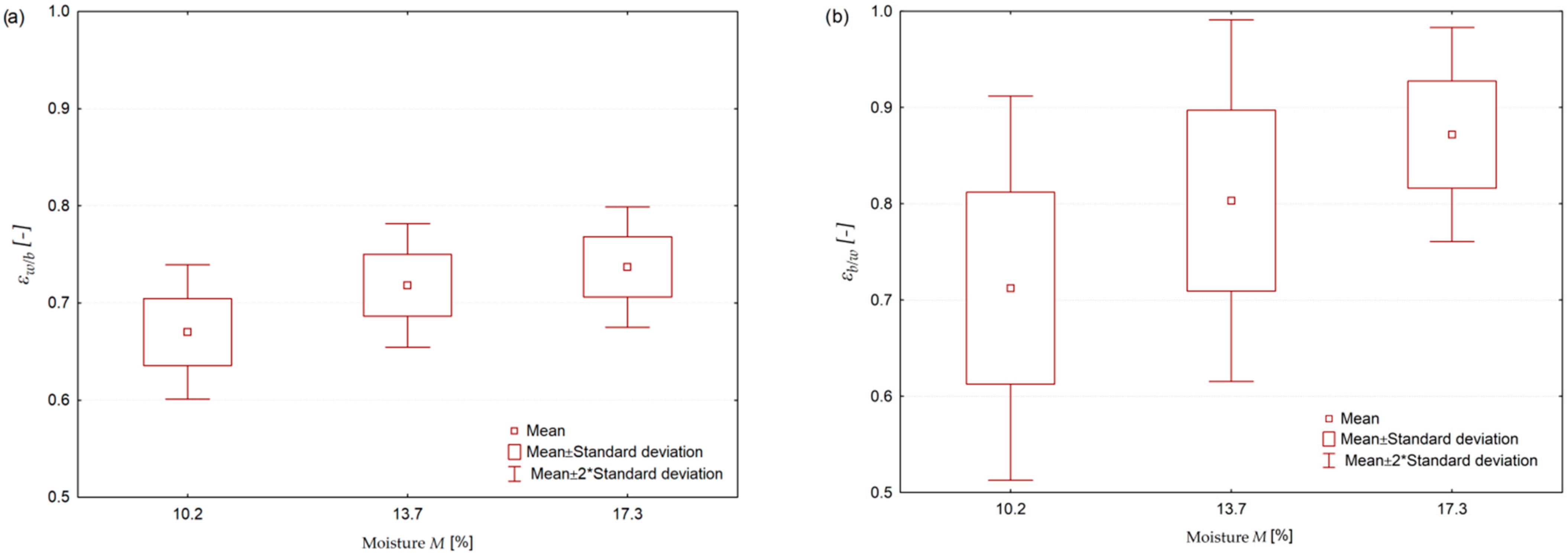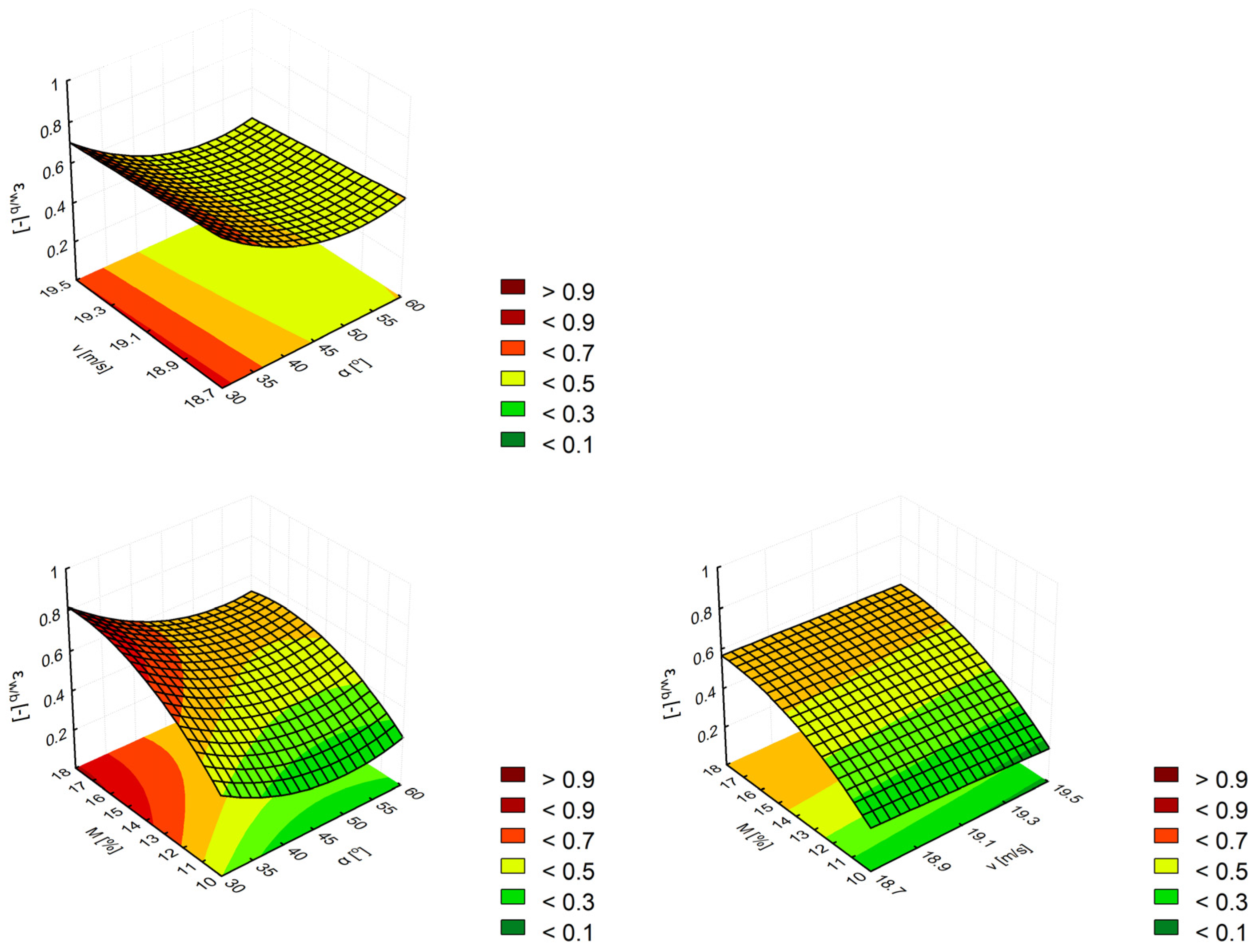The Process of Separating Buckwheat and Wheat Grain in a Pneumatic Cone Separator in the Context of Sustainable Agriculture
Abstract
:1. Introduction
2. Materials and Methods
- Fixed factors:
- -
- width of the grain inlet, s = 10 mm;
- -
- sample mass, sm = 500 g;
- -
- length of the cone’s generating line, L = 500 mm;
- -
- trough width, tw = 100 mm;
- Variable factors:
- -
- air stream velocity, v = 18.7 ÷ 19.5 m × s−1, insteps of 0.2 m × s−1;
- -
- moisture content of the model seed mixture, M = 10.1%; 13.7% and 17.3%;
- -
- cone’s apex angle, 2α = 60°, 90°, and 120°;
- -
- model seed mixture, mw/b—wheat and buckwheat, mb/w—buckwheat and wheat.
- Efficiency-related factors:
- -
- separation efficiency of mixture components: the main crop seeds and seeds imitating impurities (η)
- -
- separation efficiency index (ε).
3. Results
4. Conclusions
- The separation efficiency index (ε) exceeds 0.78 when a two-component seed mixture composed of seeds of two cereal species–wheat kernels with an elongated shape and pyramid-shaped buckwheat nutlets–are sorted in a stream of air on an immobile conical surface in a pneumatic separator.
- The efficiency (quality) of the separation process of a two-component (model) seed mixture in a pneumatic separator designed by the authors can be described with a quadratic multivariate polynomial. The regression equations describing the efficiency of mixture separation (ε) and the separation efficiency of the main crop seeds and seeds imitating impurities (η), in response to changes in the values of independent variables support accurate predictions of the parameters describing the quality of the seed separation process and can be effectively used to model and automatically control separation processes in the proposed pneumatic separator with an immobile conical surface.
- In the agri-food industry, seed mixtures can be sorted with the use of the proposed separator after the geometric and aerodynamic properties of the processed mixture components (seeds) have been determined.
Author Contributions
Funding
Institutional Review Board Statement
Informed Consent Statement
Data Availability Statement
Conflicts of Interest
References
- Bigliardi, B.; Galati, F. Innovation trends in the food industry: The case of functional foods. Trends Food Sci. Technol. 2013, 31, 118–129. [Google Scholar] [CrossRef]
- Szymańska, E. Produkcja żywca wieprzowego w zrównoważonym rozwoju rolnictwa (Production of pigs for slaughter in the sustainable development of agriculture). Zagadnienia Ekon. Rolnej 2012, 3, 89–103. [Google Scholar]
- Beluhova-Uzunova, R.P.; Dunchev, D.M. Precision Farming—Concepts and Perspectives. Zagadnienia Ekon. RolnejProbl. Agric. Econ. 2019, 3, 142–155. [Google Scholar] [CrossRef]
- Józef, Z. Zrównoważenie Polskiego Rolnictwa (Sustainability of Polish agriculture); GUS: Warszawa, Poland, 2013. [Google Scholar]
- Zegar, S.; Toczyński, T.; Wrzaszcz, W. Zrównoważenie polskiego rolnictwa w świetle danych statystyki publicznej [w:] Z badań nad rolnictwem społecznie zrównoważonym (Sustainability of Polish agriculture in the light of public statistics [in:] From research on socially sustainable agriculture). In Praca Zbiorowa Pod Red. J.S. Zegara. Raporty Programu Wieloletniego 2005–2009, Nr 8; IERiGŻ-PIB: Warszawa, Poland, 2009. [Google Scholar]
- Ötles, S.; Cagindi, Ö. Cereals based functional foods and nutraceuticals. Acta Sci. Pol. Technol. 2006, 5, 107–112. [Google Scholar]
- Kaliniewicz, Z.; Tylek, P. Aspects of the process of sorting European black pine seeds. Forests 2019, 10, 966. [Google Scholar] [CrossRef] [Green Version]
- Kaliniewicz, Z.; Choszcz, D.J. Analysis of the physical properties of seeds of selected Viburnum species for the needs of seed sorting operations. Processes 2021, 9, 711. [Google Scholar] [CrossRef]
- Kaliniewicz, Z.; Anders, A.; Markowski, P.; Tylek, P.; Owoc, D. Analysis of the physical properties of spindle seeds for seed sorting operations. Sci. Rep. 2021, 11, 13625. [Google Scholar] [CrossRef]
- Codex Alimentarius Commission. Ad Hoc Working Group on the Revision of the Standard for Gluten-Free Foods. Available online: http://eagri.cz/public/web/file/3535/al30_26e_1_.pdf (accessed on 10 November 2020).
- Kaliniewicz, Z. Modelowanie Tryjerów z Wgłębieniami Kieszonkowymi w Aspekcie Poprawy Skuteczności Czyszczenia Nasion Gryki (Modelling Trieurs with Pocket Pits in Aspect of Efficiency Improvement of Buckwheat Seeds Cleaning). Ph.D. Thesis, Politechnika Warszawska, Płock, Poland, 2000. [Google Scholar]
- Konopka, S. Analiza procesu separacji nasion gryki przy wykorzystaniu prętowych powierzchni roboczych tryjerów (Ananalysis of buckwheat seed separation process using trieur bar-type working surfaces). Inżynieria Rol. 2006, 8, 123. (In Polish) [Google Scholar]
- Kaliniewicz, Z.; Rawa, T. Analiza cech geometrycznych nasion gryki pod kątem określenia kształtu i wymiarów wgłębień tryjera cylindrycznego (Analysis of geometrical characteristics of buckwheat seeds with respect to determining shape and dimensions of cylindrical trieurpits). Probl. Inżynierii Rol. 2001, 1, 21–28. (In Polish) [Google Scholar]
- Choszcz, D.J. Efektywność rozdzielania mieszaniny nasion rzepaku i przytuli czepnej w separatorze z taśmą pętelkową (Separation efficiency for mixture of rape and cleavers seeds in separator with looped belt). Inżynieria Rol. 2009, 7, 1–107. (In Polish) [Google Scholar]
- Grochowicz, J. Maszyny do czyszczenia i sortowania nasion (Seed Cleaning and Sorting Machines). AR Lub. 1994, 2, 1–326. (In Polish) [Google Scholar]
- Panasiewicz, M.; Mazur, J.; Sobczak, P.; Zawislak, K.; Sosonska, E. Modelowanie procesu rozdziału cząsteczek w strumieniu powietrza na przykładzie rozdrobnionych mieszanin ziarnistych. Acta Agrophys. 2012, 19, 653–662. [Google Scholar]
- Gamea, G.R. Physical properties of sunflower seeds components related to kernel pneumatic separation. Int. J. Eng. Technol. 2013, 13, 103–114. [Google Scholar]
- Gregg, B.R.; Billups, G.L. Seed Conditioning, Volume 2: Technology; Taylor and Francis: New York, NY, USA, 2010. [Google Scholar]
- Gregg, B.R.; Billups, G.L. Seed Conditioning, Volume 3: Crop Seed Conditioning; Taylor and Francis: New York, NY, USA, 2010. [Google Scholar]
- Tylek, P.; Walczyk, J. Polski separator pneumatyczny do nasion drzew leśnych. Tech. Rol. Ogrod. Leśna 2007, 2, 9–10. [Google Scholar]
- Savinyh, P.; Sychugov, Y.; Kazakov, V.; Ivanovs, S. Development and Theoretical Studies of Grain Cleaning Machine for Fractional Technology of Flattening Forage Grain. Eng. Rural. Dev. 2018, 17, 124–130. [Google Scholar]
- Xu, L.; Wei, C.; Liang, Z.; Chai, X.; Li, Y.; Liu, Q. Development of rapeseed cleaning loss monitoring system and experiments in a combine harvester. Biosyst. Eng. 2019, 178, 118–130. [Google Scholar] [CrossRef]
- Bulgakov, V.; Holovach, I.; Bandura, V.; Ivanovs, S.A. A theoretical research of the grain milling technological process for roller mills with two degrees of freedom. INMATEH Agric. Eng. 2017, 52, 99–106. [Google Scholar]
- Sysuev, V.; Ivanovs, S.; Savinyh, P.; Kazakov, V. Movement and transformation of grain in two-stage crusher. Eng. Rural Dev. Proc. 2015, 14, 22–27. [Google Scholar]
- Stepanenko, S. Research pneumatic gravity separation grain materials. Int. Sci. J. Mech. Agric. 2017, 2, 143–145. [Google Scholar]
- Badretdinov, I.; Mudarisov, S.; Tuktarov, M.; Dick, E.; Arslanbekova, S. Mathematical modeling of the grain material separation in the pneumatic system of the grain-cleaning machine. J. Appl. Eng. Sci. 2017, 17, 529–534. [Google Scholar] [CrossRef]
- Choszcz, D.; Reszczyński, P. Urządzenie do Pneumatycznego Rozdzielania Nasion. Patent application No. P.403348, 28 March 2013. Patent RP, no 225931, 30 June 2017 (In Polish). [Google Scholar]
- Choszcz, D.J.; Reszczyński, P.S.; Kolankowska, E.; Konopka, S.; Lipiński, A. The Effect of Selected Factors on Separation Efficiency in a Pneumatic Conical Separator. Sustainability 2020, 12, 3051. [Google Scholar] [CrossRef] [Green Version]
- Reszczyński, P.; Wierzbicki, K. Wstępne wyniki badań separacji ziaren pszenicy i nasion wyki na nieruchomej powierzchnistożkowej. Inżynieria Rol. 2004, 8, 171–180. [Google Scholar]
- Anders, A.; Kolankowska, E.; Choszcz, D.J.; Konopka, S.; Kaliniewicz, Z. The Effect of Selected Parameters on Spelt Dehulling in a Wire Mesh Cylinder. Sustainability 2020, 12, 43. [Google Scholar] [CrossRef] [Green Version]
- Stanisz, A. Przystępny Kurs Statystyki w Oparciu o Program STATISTICA PL na Przykładach z Medycyny. Tom 2. Modele Liniowe i Nieliniowe (Accessible Course in Statistics Based on the STATISTICA PL Software on Examples from Medicine. Tome 2. Linear and Nonlinear Models); StatSoft Polska: Kraków, Poland, 2007. [Google Scholar]
- Rabiej, M. Statystyka z Programem Statistica; Helion: Gliwice, Poland, 2012. [Google Scholar]
- Woliński, J.; Wolińska, J.; Kapela, K.; Wyrzykowska, M. Ocena wpływu wilgotności na podstawowe cechy fizyczne nasion gryki odmiany Luba. Inżynieria Rol. 2011, 15, 287–291. [Google Scholar]
- Kram, B.B. Badania współczynnika tarcia zewnętrznego ziarna zbóż w funkcji wilgotności. Inżynieria Rol. 2006, 10, 175–182. [Google Scholar]
- Kopeć-Jarosz, A.; Wójcik, A. The Impact of Moisture and Number of Contact Points on the Process of Friction in Plant Granular Materials. Processes 2021, 9, 215. [Google Scholar] [CrossRef]
- Horabik, J.; Molenda, M. Physical properties of granular food materials Draft of catalogue. Acta Agrophys. 2002, 74, 3–89. [Google Scholar]
- Konopka, S.; Choszcz, D.J.; Markowski, P. Optimization of the Separation Parameters and Indicators of Separation Efficiency of Buckwheat Seeds. Sustainability 2017, 9, 2134. [Google Scholar] [CrossRef] [Green Version]
- Konopka, S.; Markowski, P.; Kaliniewicz, Z.; Choszcz, D.J.; Lipiński, A.J.; Kusińska, E. Optimization of the Separation Efficiency of Buckwheat Seeds and Wild Radish Siliques in a Grader with Indented Pockets. Sustainability 2018, 10, 3870. [Google Scholar] [CrossRef] [Green Version]
- Pozeliene, A.; Lynikiene, S.; Sapailaite, I.; Sakalauskas, A. Utilization of strong electric field for special cleaning buckwheat seeds. Agron. Res. 2008, 6, 291–298. [Google Scholar]
- Pozeliene, A.; Lynikiene, S.; Sapailaite, I. Use of electroseparator in improving the quality of ecological buckwheat seeds. Žemes Ukio Moksl. 2010, 17, 56–59. [Google Scholar]
- Kaliniewicz, Z.; Konopka, S.; Rawa, T.; Wierzbicki, K. Propozycje nowych maszyn do czyszczenia ziarna gryki (Proposals of New machines to dry-cleaning of buckwheat grain). Zesz. Probl. Postępów Nauk. Rol. 2002, 486, 333–340. (In Polish) [Google Scholar]
- Choszcz, D.; Konopka, S.; Wierzbicki, K. Wyniki badań wstępnych skuteczności czyszczenia nasion gryki w fotoelektrycznym separatorze (Preliminary test results of the efficiency of buckwheat seed cleaning in a photoelectric separator). Inżynieria Rol. 2003, 7, 17–22. (In Polish) [Google Scholar]






| Mixture | Indicator | Minimum | Maximum | Mean | Standard Deviation | Coefficient of Variation [%] |
|---|---|---|---|---|---|---|
| Wheat and buckwheat | ηw [%] | 70.39 | 95.67 | 84.06 | 7.808 | 9.29 |
| ηb [%] | 75.05 | 94.85 | 84.59 | 4.246 | 5.02 | |
| εw/b [-] | 0.62 | 0.78 | 0.71 | 0.043 | 6.02 | |
| Buckwheat and wheat | ηb [%] | 75.95 | 98.9 | 93.90 | 5.982 | 6.37 |
| ηw [%] | 66.52 | 95.67 | 84.56 | 8.281 | 9.79 | |
| εb/w [-] | 0.59 | 0.92 | 0.77 | 0.096 | 12.45 |
| Mixturetype | Indicator | Quadratic Equation for Two Independent Variables | F-Statistic 0.05 | Coefficient of Determination R2 0.955 | Adjusted R2 | Standard Error of the Estimate 30.785 | Probability (p) |
|---|---|---|---|---|---|---|---|
| Wheat and buckwheat | ηw [%] | 59.350 | 0.884 | 0.869 | 0.031 | 0.00 | |
| ηb [%] | 87.098 | 0.943 | 0.932 | 0.005 | 0.00 | ||
| εw/b [-] | 26.812 | 0.809 | 0.779 | 0.015 | 0.00 | ||
| Buckwheat and wheat | ηb [%] | 81.245 | 0.928 | 0.916 | 0.011 | 0.00 | |
| ηw [%] | 79.130 | 0.910 | 0.899 | 0.027 | 0.00 | ||
| εb/w [-] | 231,507 | 0.959 | 0.954 | 0.021 | 0.00 |
Publisher’s Note: MDPI stays neutral with regard to jurisdictional claims in published maps and institutional affiliations. |
© 2021 by the authors. Licensee MDPI, Basel, Switzerland. This article is an open access article distributed under the terms and conditions of the Creative Commons Attribution (CC BY) license (https://creativecommons.org/licenses/by/4.0/).
Share and Cite
Kolankowska, E.; Choszcz, D.J.; Markowski, P.; Reszczyński, P.S.; Lipiński, A.J. The Process of Separating Buckwheat and Wheat Grain in a Pneumatic Cone Separator in the Context of Sustainable Agriculture. Processes 2022, 10, 59. https://doi.org/10.3390/pr10010059
Kolankowska E, Choszcz DJ, Markowski P, Reszczyński PS, Lipiński AJ. The Process of Separating Buckwheat and Wheat Grain in a Pneumatic Cone Separator in the Context of Sustainable Agriculture. Processes. 2022; 10(1):59. https://doi.org/10.3390/pr10010059
Chicago/Turabian StyleKolankowska, Ewelina, Dariusz Jan Choszcz, Piotr Markowski, Patrycjusz Sebastian Reszczyński, and Adam Józef Lipiński. 2022. "The Process of Separating Buckwheat and Wheat Grain in a Pneumatic Cone Separator in the Context of Sustainable Agriculture" Processes 10, no. 1: 59. https://doi.org/10.3390/pr10010059
APA StyleKolankowska, E., Choszcz, D. J., Markowski, P., Reszczyński, P. S., & Lipiński, A. J. (2022). The Process of Separating Buckwheat and Wheat Grain in a Pneumatic Cone Separator in the Context of Sustainable Agriculture. Processes, 10(1), 59. https://doi.org/10.3390/pr10010059






